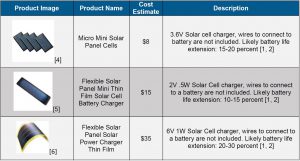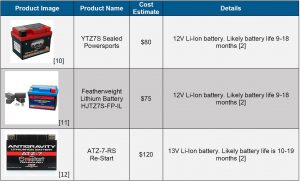an email newsletter released every month highlighting the latest articles, events, technical inquiries, and voices from the community
Are there any novel charging solutions or batteries with longer life expectancy?

Posted on May 8, 2019 | Completed on May 8, 2019
Are there any novel charging solutions or batteries with longer life expectancy?
Overview
A member of Cochise County Sheriff’s Office (AZ) requested information regarding novel recharging systems or batteries with longer life expectancy. This information will support the development of a new power-supply system capable of extending the functional usage of their field cameras beyond the existing timeframe of approximately three to six months.
Findings
The Homeland Defense and Security Information Analysis Center (HDIAC) identified several options for self-charging systems and longer-duration batteries. HDIAC found that the best approach is to exchange the current lead-acid batteries for lithium-ion (Li-ion) batteries of a similar size and charge capacity. Several HDIAC subject matter experts (SMEs) confirmed this as the best approach, and HDIAC analysts could not identify any technical reason prohibiting the integration of existing field camera systems with Li-ion batteries. However, because this approach would potentially require a new battery/field camera system vendor, an alternative approach is provided. For a short-term solution, HDIAC recommends the integration of a solar cell (as opposed to a solar panel) in order to increase the life of current lead-acid batteries by as much as 30 percent.
Solar Cells
To extend the existing lead-acid battery (UB1290), a solar cell energy harvester is the recommended option. These are similar to solar panels, which utilize thermal and light energy to charge a battery. However, these solar cells are extremely thin, highly pliable, and much less reflective.
A smartphone-sized solar cell fitted to the top of a UB1290 receiving 75 percent of sunlight during the course of a day would lengthen a battery’s life by 20-30 percent. This would push the life expectancy of each unit up to almost eight months from six months. However, larger solar cell units could achieve greater solar energy collection and, as a result, greater battery life extension. HDIAC SMEs from Missouri University of Science and Technology highly recommended this solution [1-3].
Table 1: Battery Charging Products

These solar cells are relatively affordable and easy to install on the battery itself. Also, it is likely that vendors would be able to assist in mitigating the color and reflective traits of their solar cells to improve concealability. The solar cell would need relatively low obstruction above it (branches, bushes) in order to collect an adequate amount of sunlight.
Radio Frequency (RF) Harvesting
This technology harvests energy from RFs ranging from 3 kHz to 300 GHz (frequency of camera data transfer falls inside this range) and can harvest the energy from ambient RF or active RF. However, the amount of energy that can be harvested depends on the proximity of the RF source, wavelength, transmit power, and harvesting system. Because of these factors, energy collected in remote areas may be small. RF energy harvesters also require additional antennas, RF to DC converters, and DC power management circuity in order to operate. However, these additions are minor and can be easily concealed. Due to how each camera communicates with one another, a specific camera’s communication could contribute to trickle-charge another camera’s battery [3-7].
Li-ion Batteries
Should a new battery type be required, Li-ion batteries represent the best solution. Li-ion batteries (solid-state and flow battery variations) are employed throughout government and private sectors for scenarios requiring sustained power. HDIAC SMEs highly recommend the use of Li-ion batteries over current lead-acid batteries, as these batteries’ life expectancy is two to three times longer. Additionally, Li-ion batteries are available in similar dimensions to the existing UB1290s, allowing for similar concealment options. Finally, the inclusion of a solar cell charging panel into an Li-ion battery could see the lifetime of these larger capacity batteries extended by an additional 20-30 percent [1, 2, 8, 9].
Table 2: Battery Technology

Conclusion
HDIAC identified multiple options for enhancing a battery’s life expectancy while maintaining concealability. These include both self-charging systems and the implementation of higher-capacity batteries. For a short-term solution, HDIAC recommends the use of a solar cell charger. A solar cell charging system is relatively concealable and can allow for up to 30 percent battery life extension. A longer-term solution, as recommended by HDIAC SMEs, is an Li-ion battery due to its larger charge capacity and energy density over a lead-acid battery, coupled with a solar cell panel for extended life expectancy. Again, HDIAC found no technical reason as to why a lithium battery could not be used with current camera systems, as the physical parameters and energy output are comparable to the existing UB1290.
References
[1] Park, J., (2019, April 1). Alternative battery solutions [E-mail]
[2] Li, J., (2019, April 1). Alternative battery solutions [E-mail]
[3] Preauzek, M., Konecny, J., Borova, M., Janosova, K., Hlavica, J., Musilek, P. (2018, July 27) Energy Harvesting Sources, Storage Devices and System Topologies for Environmental Wireless Sensor Networks: Review (HDIAC-216140). Perf Org: Technical University of Ostrava.
[4] Nuzamas. [NUZAMAS 5V 30mA 53X30mm Micro Mini Solar Panel Cells for Solar Power Energy] Retrieved from: https://www.amazon.com/Pieces-NUZAMAS-53X30mm-Science-Projects/dp/B06ZZCV99D/ref=sr_1_24?keywords=Thin+solar+cell&qid=1554314415&s=lawn-garden&sr=1-24
[5] Nuzamas. [NUZAMAS Flexible Solar Panel Mini Thin Film Solar Cell Battery Charger] Retrieved from: https://www.amazon.com/NUZAMAS-Flexible-Battery-Charging-Projects/dp/B07D289CJG/ref=asc_df_B07D289CJG/?tag=hyprod-20&linkCode=df0&hvadid=241942867107&hvpos=1o15&hvnetw=g&hvrand=17628513344577046109&hvpone=&hvptwo=&hvqmt=&hvdev=c&hvdvcmdl=&hvlocint=&hvlocphy=9013403&hvtargid=pla-485893363174&psc=1
[6] Jiang. [Flexible Solar Panel Solar Power Charger Thin Film] Retrieved from: https://express.google.com/u/0/product/3629349547929284610_16159287220917570094_7695788?utm_source=google_shopping&utm_medium=tu_prop&utm_content=eid-lsjeuxoeqt%2Ceid-vqiqlmovzs>im=CISCqZr5qey02gEQ6JeaxrWm1s1bGODd0A8iA1VTRCjgiqPmBTCs29UD&utm_campaign=7695788&gclid=EAIaIQobChMI7si6kLq04QIVDZyzCh3IBQLQEAkYASABEgI0rvD_BwE
[7] Lu, X., Wang, P., Niyato, D., Kim, D., Han, Z. (2014, September 5) Wireless Networks with RF Energy Harvesting: A Contemporary Survey. Scholarly Project, Retrieved from: https://arxiv.org/pdf/1406.6470.pdf
[8] Hutcheon, A., Campbell, J. (2018, September). Energy Storage Systems and Utility Cost Savings for DoD Installations. Thesis (HDIAC-216624). Perf. Org. Naval Postgraduate School.
[9] Energy Storage Association, (2019). Energy Storage Technologies. Retrieved from: http://energystorage.org/energy-storage/energy-storage-technologies
[10] MMG. [YTZ7S Lithium Ion Sealed Powersports Battery 12V Powerful 150CCA] Retrieved from: https://www.amazon.com/Powersports-Powerful-Activated-Motorcycles-Scooters/dp/B00CGNCNPY/ref=asc_df_B00CGNCNPY/?tag=hyprod-20&linkCode=df0&hvadid=312195936700&hvpos=1o1&hvnetw=g&hvrand=16498623926368603017&hvpone=&hvptwo=&hvqmt=&hvdev=c&hvdvcmdl=&hvlocint=&hvlocphy=9013403&hvtargid=pla-571077996137&psc=1#HLCXComparisonWidget_feature_div
[11] FirePower [FirePower Featherweight Lithium Battery HJTZ7S-FP-IL] Retrieved from: https://www.amazon.com/dp/B00DX891FG/ref=psdc_404722011_t1_B00CGNCNPY
[12] Antigravity Batteries [Antigravity ATZ-7-RS Lithium RE-START Battery] Retrieved from: https://www.amazon.com/dp/B079V1B82Y/ref=psdc_404722011_t3_B00CGNCNPY
Want to find out more about this topic?
Request a FREE Technical Inquiry!

